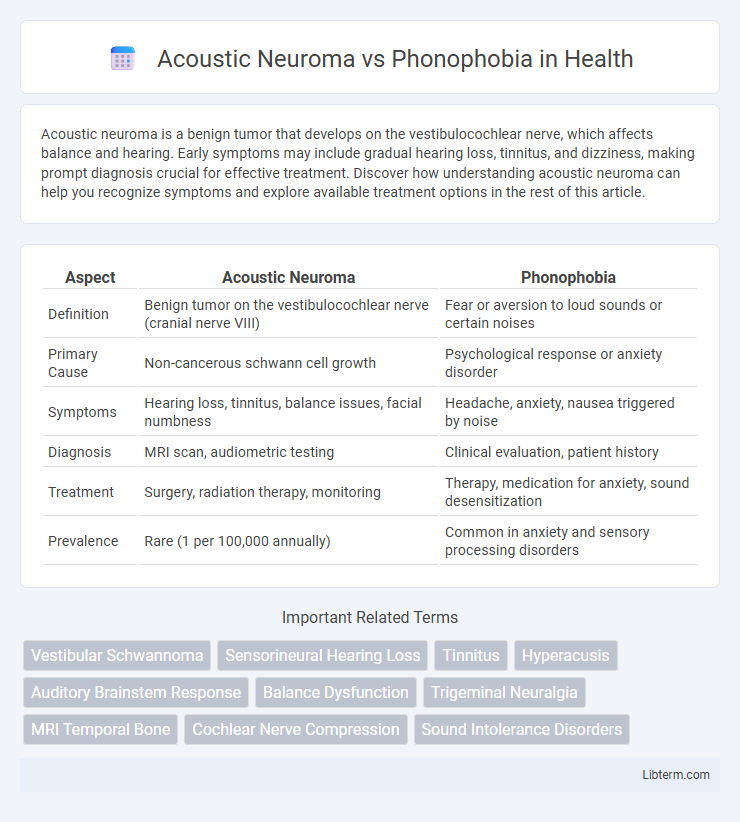Acoustic neuroma is a benign tumor that develops on the vestibulocochlear nerve, which affects balance and hearing. Early symptoms may include gradual hearing loss, tinnitus, and dizziness, making prompt diagnosis crucial for effective treatment. Discover how understanding acoustic neuroma can help you recognize symptoms and explore available treatment options in the rest of this article.
Table of Comparison
| Aspect | Acoustic Neuroma | Phonophobia |
|---|---|---|
| Definition | Benign tumor on the vestibulocochlear nerve (cranial nerve VIII) | Fear or aversion to loud sounds or certain noises |
| Primary Cause | Non-cancerous schwann cell growth | Psychological response or anxiety disorder |
| Symptoms | Hearing loss, tinnitus, balance issues, facial numbness | Headache, anxiety, nausea triggered by noise |
| Diagnosis | MRI scan, audiometric testing | Clinical evaluation, patient history |
| Treatment | Surgery, radiation therapy, monitoring | Therapy, medication for anxiety, sound desensitization |
| Prevalence | Rare (1 per 100,000 annually) | Common in anxiety and sensory processing disorders |
Introduction to Acoustic Neuroma and Phonophobia
Acoustic neuroma is a benign tumor that develops on the vestibulocochlear nerve, affecting hearing and balance, while phonophobia is a heightened sensitivity or fear of loud sounds often linked to migraines or anxiety disorders. Acoustic neuroma symptoms include hearing loss, tinnitus, and dizziness, whereas phonophobia manifests as discomfort or pain triggered by everyday noises. Early diagnosis of acoustic neuroma involves MRI imaging, whereas phonophobia diagnosis typically relies on clinical evaluation and patient history.
Defining Acoustic Neuroma: Causes and Symptoms
Acoustic neuroma is a benign tumor developing on the vestibulocochlear nerve, often caused by genetic mutations in the NF2 gene. Symptoms include unilateral hearing loss, tinnitus, balance issues, and sometimes facial numbness or weakness. Early diagnosis through MRI and audiometric tests is crucial for effective management and treatment options.
Understanding Phonophobia: Triggers and Manifestations
Phonophobia is characterized by an intense fear or aversion to loud sounds, frequently triggered by common environmental noises such as traffic, alarms, or sudden bursts of noise. Unlike Acoustic Neuroma, a benign tumor affecting the acoustic nerve and leading to hearing loss or tinnitus, phonophobia primarily manifests as heightened auditory sensitivity and associated anxiety or headache symptoms. Understanding phonophobia involves recognizing its psychological and sensory triggers, which can significantly impair a person's quality of life through avoidance behaviors and stress responses.
Key Differences Between Acoustic Neuroma and Phonophobia
Acoustic neuroma is a benign tumor on the vestibulocochlear nerve that primarily causes hearing loss, tinnitus, and balance issues, whereas phonophobia is a hypersensitivity or fear of loud sounds often linked to migraine or anxiety disorders. Acoustic neuroma involves structural nerve damage detectable through MRI, while phonophobia manifests as a neurological or psychological reaction without physical nerve abnormalities. Treatment for acoustic neuroma may require surgery or radiation, whereas phonophobia is managed through behavioral therapy and headache medication.
Diagnosis: Acoustic Neuroma vs Phonophobia
Diagnosis of Acoustic Neuroma relies on imaging techniques such as MRI and audiometric tests to detect vestibular Schwannoma tumors affecting the eighth cranial nerve. In contrast, Phonophobia diagnosis involves clinical evaluation of auditory hypersensitivity and patient history without structural abnormalities on imaging. Differentiating Acoustic Neuroma from Phonophobia requires correlating neurological symptoms with radiological findings to exclude tumor presence.
Impact on Hearing and Balance
Acoustic neuroma, a benign tumor on the vestibulocochlear nerve, often causes progressive hearing loss, tinnitus, and balance disturbances due to nerve compression. Phonophobia, an abnormal sensitivity to sound, typically does not result in permanent hearing loss or balance issues but intensifies discomfort and anxiety in noisy environments. Understanding these differences is crucial for accurate diagnosis and targeted treatment strategies to preserve auditory and vestibular function.
Psychological vs Physiological Effects
Acoustic neuroma primarily causes physiological effects such as hearing loss, tinnitus, and balance disturbances due to pressure on the auditory nerve, whereas phonophobia's effects are predominantly psychological, manifesting as an intense fear or anxiety triggered by specific sounds. The physiological impact of acoustic neuroma involves nerve compression and potential neurological deficits, contrasting with phonophobia's heightened emotional and behavioral responses to auditory stimuli. Understanding these distinctions aids in targeted diagnosis and treatment, emphasizing neurological intervention for acoustic neuroma and cognitive-behavioral approaches for phonophobia.
Treatment Options for Acoustic Neuroma
Treatment options for Acoustic Neuroma include microsurgical removal, stereotactic radiosurgery, and careful monitoring through a "watch and wait" approach, depending on tumor size and patient health. Microsurgery aims to excise the tumor while preserving facial nerve function, whereas stereotactic radiosurgery delivers targeted radiation to halt tumor growth with minimal invasiveness. Unlike Phonophobia, which primarily requires behavioral therapy or sound desensitization, Acoustic Neuroma demands medical or surgical interventions due to its physical tumor presence.
Management Strategies for Phonophobia
Management strategies for phonophobia primarily involve sound therapy, cognitive-behavioral therapy (CBT), and relaxation techniques to reduce sensitivity to sound triggers. Usage of ear protection and gradual exposure to increasing sound levels can help desensitize patients and improve tolerance. Pharmacological interventions, such as anxiolytics or antidepressants, may be prescribed in severe cases to manage associated anxiety symptoms.
Prognosis and Quality of Life Considerations
Acoustic neuroma prognosis depends on tumor size and treatment approach, with smaller tumors often managed successfully through monitoring or surgery, preserving hearing and balance functions. Phonophobia, commonly linked to migraine disorders, varies in severity but generally improves with targeted therapy, significantly enhancing patients' quality of life by reducing sound sensitivity and associated anxiety. Both conditions require tailored management plans to optimize long-term outcomes and maintain overall well-being.
Acoustic Neuroma Infographic

 libterm.com
libterm.com